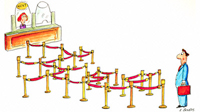With one click of the mouse, the guest turns into ... turns into the guest ...
How do you decide whether to register on the new service?
 How many seconds and clicks are needed to assess the usefulness of the resource? Did the authors take care that with a minimal amount of body movements you understand what its essence is and estimate your benefits from its use?
How many seconds and clicks are needed to assess the usefulness of the resource? Did the authors take care that with a minimal amount of body movements you understand what its essence is and estimate your benefits from its use?
In order for as many doubting guests as possible to become full-fledged users, the authors could come up with a talking title or a capacious slogan: a story similar to MyWishList and FlashPhone (but very far from Habrahabr and Lepre ).
')
They could also put a textual description on their homepage à la Lifehacker or Webby . Or, a separate section was identified for this description, hidden behind the “About the Project” link (a universal version that does not need examples, which does not always affect the increase of any conversion at all).
But the most caring and hardworking authors could provide for their guests a very pleasant opportunity: to launch a demonstration and, leaning back in his chair, get all the necessary information about the service in a clear and understandable way.
This could be done in the form of a turn-based tour, where each page tells a bright story about one of the site’s possibilities. Digg , Flickr and the domestic Startup from Pasha followed this path.
And finally, the authors could make a flash-presentation, like Gooroo or TeamWeaver , or a video clip, in all its colors telling about the charms of owning an account here.
Were not too lazy to make a video presentation Twitter :
Gmail :
Domestic Dubbee :
The last option, although it seems to be very laborious in production, doesn’t it allow you to describe your creation as clearly as possible and thereby attract new users? Why should not all services make flash or video films of their own, so that each new visitor to their site can easily decide whether he needs it or not?
 How many seconds and clicks are needed to assess the usefulness of the resource? Did the authors take care that with a minimal amount of body movements you understand what its essence is and estimate your benefits from its use?
How many seconds and clicks are needed to assess the usefulness of the resource? Did the authors take care that with a minimal amount of body movements you understand what its essence is and estimate your benefits from its use?In order for as many doubting guests as possible to become full-fledged users, the authors could come up with a talking title or a capacious slogan: a story similar to MyWishList and FlashPhone (but very far from Habrahabr and Lepre ).
')
They could also put a textual description on their homepage à la Lifehacker or Webby . Or, a separate section was identified for this description, hidden behind the “About the Project” link (a universal version that does not need examples, which does not always affect the increase of any conversion at all).
But the most caring and hardworking authors could provide for their guests a very pleasant opportunity: to launch a demonstration and, leaning back in his chair, get all the necessary information about the service in a clear and understandable way.
This could be done in the form of a turn-based tour, where each page tells a bright story about one of the site’s possibilities. Digg , Flickr and the domestic Startup from Pasha followed this path.
And finally, the authors could make a flash-presentation, like Gooroo or TeamWeaver , or a video clip, in all its colors telling about the charms of owning an account here.
Were not too lazy to make a video presentation Twitter :
Gmail :
Domestic Dubbee :
The last option, although it seems to be very laborious in production, doesn’t it allow you to describe your creation as clearly as possible and thereby attract new users? Why should not all services make flash or video films of their own, so that each new visitor to their site can easily decide whether he needs it or not?
Source: https://habr.com/ru/post/30291/
All Articles